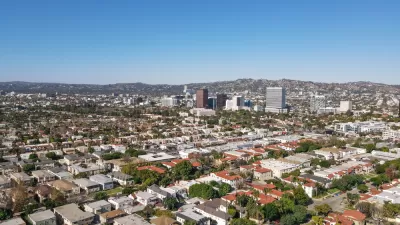The state of California has long looked the other way while cities blocked growth. With the state now enforcing growth plans, more and more cities are faced with losing local control of zoning. Introducing the “Builder's Remedy."

One of the biggest stories in planning anywhere in the country right now is the growing number of California cities that have run afoul of state requirements for the Regional Housing Needs Assessment (RHNA) process, forfeiting local control of zoning approvals in the process and ushering a new planning term that completely upends the planning status quo: the Builder's Remedy.
An article by Liam Dillon for Los Angeles Times sheds new light on the Builder's Remedy, a policy tool that could have pressed local governments to plan for more housing, but went unused until reports about the city of Davis' being among the first in the state to face the consequences of failing the RHNA process. Davis would soon be followed by cities like Santa Monica. Santa Monica would later approve a revised housing plan, bringing the city into compliance, but not before development plans for 4,500 new residential units made it into the development pipeline. The largest city in the state, Los Angeles, avoided the Builder's Remedy by approving a revised Housing Element of the city's General Plan.
“Beverly Hills, Huntington Beach, Malibu, Palm Springs, Pasadena and West Hollywood are among the 124 jurisdictions in Los Angeles, Orange, Riverside, San Bernardino and Imperial counties where the builder’s remedy could be in play because their latest housing plan hasn’t been approved,” report Dillon, citing confirmation from the state Department of Housing and Community Development as evidence. “Coronado, Del Mar and Solana Beach are among 11 cities in San Diego County in the same circumstances. Bay Area cities’ housing plans are due in January.”
Much of Dillon's analysis focuses on Santa Monica, a city with a complicated housing record, passing one of the nation's strongest rent control laws in the 1970s but subsequently allowing little room to grow, and holding basically steady in population as a result.
“In the decades since, regular disputes have erupted over proposals for large housing and commercial developments. Most recently, debates have centered on tearing down a downtown parking garage and replacing it with low-income housing, as well as building a 521-unit apartment building on what’s now a strip mall anchored by a grocery store,” writes Dillon.
With the city only temporarily out of compliance with the RHNA process, Dillon reports that a slow growth organization known as Santa Monica Coalition for a Livable City “is urging the City Council to consider litigation to stop the projects.” Dillon notes that the California Environmental Quality Act (CEQA) is likely to present a sticking point for large projects proposed under the Builder's Remedy. “Additionally, because the builder’s remedy is untested in court, legal questions remain over what developments qualify,” writes Dillon.
FULL STORY: Thousands of apartments may come to Santa Monica, other wealthy cities under little-known law

Alabama: Trump Terminates Settlements for Black Communities Harmed By Raw Sewage
Trump deemed the landmark civil rights agreement “illegal DEI and environmental justice policy.”

Planetizen Federal Action Tracker
A weekly monitor of how Trump’s orders and actions are impacting planners and planning in America.

The 120 Year Old Tiny Home Villages That Sheltered San Francisco’s Earthquake Refugees
More than a century ago, San Francisco mobilized to house thousands of residents displaced by the 1906 earthquake. Could their strategy offer a model for the present?

In Both Crashes and Crime, Public Transportation is Far Safer than Driving
Contrary to popular assumptions, public transportation has far lower crash and crime rates than automobile travel. For safer communities, improve and encourage transit travel.

Report: Zoning Reforms Should Complement Nashville’s Ambitious Transit Plan
Without reform, restrictive zoning codes will limit the impact of the city’s planned transit expansion and could exclude some of the residents who depend on transit the most.

Judge Orders Release of Frozen IRA, IIJA Funding
The decision is a victory for environmental groups who charged that freezing funds for critical infrastructure and disaster response programs caused “real and irreparable harm” to communities.
Urban Design for Planners 1: Software Tools
This six-course series explores essential urban design concepts using open source software and equips planners with the tools they need to participate fully in the urban design process.
Planning for Universal Design
Learn the tools for implementing Universal Design in planning regulations.
Clanton & Associates, Inc.
Jessamine County Fiscal Court
Institute for Housing and Urban Development Studies (IHS)
City of Grandview
Harvard GSD Executive Education
Toledo-Lucas County Plan Commissions
Salt Lake City
NYU Wagner Graduate School of Public Service





























